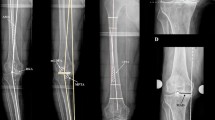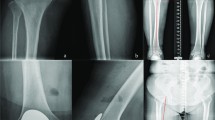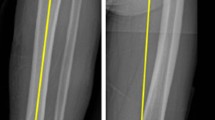Abstract
Purpose
To achieve a higher level of satisfaction in patients having undergone Total Knee Arthroplasty (TKA), a more personalized approach has been discussed recently. It can be assumed that a more profound knowledge of bony morphology and ligamentous situation would be beneficial. While CT/MRI can give 3D information on bone morphology, the understanding of the ligamentous situation in different flexion angles is still incomplete. In this study, the dynamic gap widths of a large number of varus knees were assessed in various flexion angles, to find out whether all varus knees behave similar or have more individual soft tissue patterns. Additionally, it was investigated whether the amount of varus deformity or other patient factors have an effect on joint gap widths.
Methods
A series of 1000 consecutive TKA patients, including their CAS data and patient records were analyzed. Joint gap widths in multiple flexion angles (0°, 30°, 60°, 90°) were measured in mm and differences between the joint gaps were compared. A “standard” varus knee was defined as follows: (1) Lateral extension gap greater than medial, (2) lateral flexion gap greater than medial, and (3) flexion gap greater than extension gap. The percentage of fulfillment was tested for each and all criteria. To measure the influence of varus deformity on gap width difference, three subgroups were formed based on the deformity. Data were analyzed at 0°, 30°, 60° and 90° flexion. The effect of patient factors (gender, BMI, age) on gap sizes was tested by performing subgroup analyses.
Results
Only 444 of 680 (65%) patients met all three varus knee criteria. The lateral extension gap (4.1 mm) was significantly larger than the medial extension gap (0.6 mm) in 657 (97%) patients and the gap difference highly correlated with the amount of varus deformity (r2 = 0.62). In all flexion positions, however, no correlation between gap differences and varus deformity existed. Women had significantly larger extension and flexion gaps. Age and BMI showed no significant effect on gap widths.
Conclusion
Varus knees show a large inter-individual variability regarding gap widths and gap differences. The amount of varus deformity correlates highly with the medio-lateral gap difference in extension, but not in any flexion angle. As varus knees are not all alike, a uniform surgical technique will not treat all varus knees adequately and the individual gap sizes need to be analyzed and addressed accordingly with an individualized balancing technique. Which final balancing goal should be achieved needs to be analyzed in future studies.
Level of evidence
Level III.

Similar content being viewed by others
References
Gunaratne R, Pratt DN, Banda J, Fick DP, Khan RJK, Robertson BW (2017) Patient dissatisfaction following total knee arthroplasty: a systematic review of the literature. J Arthoplasty 32:3854–3860
Kahlenberg CA, Nwachukwu BU, McLawhorn AS, Cross MB, Cornell CN, Padgett DE (2018) Patient satisfaction after total knee replacement: a systematic review. HSS J 14(2):192–201
Canovas F, Dagneaux L (2018) Quality of life after total knee arthroplasty. Orthop Traumatol Surg Res 104:41–46
Choi YJ, Ra HJ (2016) Patient satisfaction after total knee arthroplasty. Knee Surg Relat Res 28(1):1–15
Hossain FS, Konan S, Patel S, Rodriguez-Merchan EC, Haddad FS (2015) The assessment of outcome after total knee arthroplasty: are we there yet? Bone Joint J 97-B:3–9
Nam D, Nunley RM, Barrack RL (2014) Patient dissatisfaction following total knee replacement: a growing concern? Bone Joint J 96-B:96–100
Smith AF, Eccles CJ, Bhimani SJ, Denehy KM, Bhimani RB, Smith LS, Malkani AL (2021) Improved patient satisfaction following robotic-assisted total knee arthroplasty. J Knee Surg 34(7):730–738
Almaawi AM, Hutt JRB, Masse V, Lavigne M, Vendittoli PA (2017) The impact of mechanical and restricted kinematic alignment on knee anatomy in total knee arthroplasty. J Arthoplasty 32:2133–2140
Hirschmann MT, Müller W (2015) Complex function of the knee joint: the current understanding of the knee. Knee Surg Sports Traumatol Arthrosc 23:2780–2788
Kim K, Kim J, Lee D, Lim S, Eom J (2019) The accuracy of alignment determined by patient-specific instrumentation system in total knee arthroplasty. Knee Surg Relat Res 31(1):19–24
Rivière C, Iranpour F, Auvinet E, Howell S, Vendittoli PA, Cobb J, Parratte S (2017) Alignment options for total knee arthroplasty: a systematic review. Orthop Traumatol Surg Res 103(7):1047–1056
Hirschmann MT, Moser LB, Amsler F, Behrend H, Leclerq V, Hess S (2019) Functional knee phenotypes: a novel classification for phenotyping the coronal lower limb alignment based on the native alignment in young non-osteoarthritic patients. Knee Surg Sports Traumatol Arthrosc 27(5):1394–1402
Bellemans J, Colyn W, Vandenneucker H, Victor J (2012) The Chitranjan Ranawat award: is neutral mechanical alignment normal for all patients? The concept of constitutional varus. Clin Orthop Relat Res 470:45–53
Confalonieri N, Biazzo A (2019) Computer-assisted surgery in total knee replacement: advantages, surgical procedure and review of the literature. Acta Biomed 90(1):16–23
Lee DH, Park JH, Song DI, Padhy D, Jeong WK, Han SB (2010) Accuracy of soft tissue balancing in TKA: comparison between navigation-assisted gap balancing and conventional measured resection. Knee Surg Sports Traumatol Arthrosc 18:381–387
Moon YW, Kim HJ, Ahn HS, Park CD, Lee DH (2016) Comparison of soft tissue balancing, femoral component rotation, and joint line change between the gap balancing and measured resection techniques in primary total knee arthroplasty: a meta-analysis. Medicine (Baltimore). https://doi.org/10.1097/MD.0000000000005006
Bagaria V, Sadigale OS, Pawar PP, Bashyal RK, Achalare A, Poduval M (2020) Robotic-assisted knee arthroplasty (RAKA): the technique, the technology and the transition. Indian J Orthop 54(6):745–756
Deep K, Shankar S, Mahendra A (2017) Computer assisted navigation in total knee and hip arthroplasty. SICOT J. https://doi.org/10.1051/sicotj/2017034
Hannan R, Free M, Arora V, Harle R, Harvie P (2020) Accuracy of computer navigation in total knee arthroplasty: a prospective computed tomography-based study. Med Eng Phys 79:52–59
Pertusson G, Fenstad AM, Gothesen O, Dyrhovden GS, Hallan G, Röhrl SM, Aamodt A, Furnes O (2018) Computer-assisted compared with conventional total knee replacement: a multicenter parallel-group randomized controlled trial. J Bone Joint Surg Am 100(15):1265–1274
van der List JP, Chawla H, Joskowicz L, Pearle AD (2016) Current state of computer navigation and robotics in unicompartmental and total knee arthroplasty: a systematic review with meta-analysis. Knee Surg Sports Traumatol Arthrosc 24(11):3482–3495
Mehliß V, Leira MS, Olaizola AS, Scior W, Graichen H (2019) Proven accuracy for a new dynamic gap measurement in navigated TKA. Knee Surg Sports Traumatol Arthrosc 27:1189–1195
Hirschmann MT, Hess S, Behrend H, Amsler F, Leclercq V, Moser LB (2019) Phenotyping of hip-knee-ankle angle in young non-osteoarthritic knees provides better understanding of native alignment variability. Knee Surg Sports Traumatol Arthrosc 27:1378–1384
Moser LB, Hess S, Amsler F, Behrend H, Hirschmann MT (2019) Native non-osteoarthritic knees have a highly variable coronal alignment: a systematic review. Knee Surg Sports Traumatol Arthrosc 27:1359–1367
Thienpont E, Parvizi J (2016) A new classification for the varus knee. J Arthroplasty 31:2156–2160
Deep K, Picard F, Baines J (2016) Dynamic knee behaviour: does the knee deformity change as it is flexed-an assessment and classification with computer navigation. Knee Surg Sports Traumatol Arthrosc 24:3575–3583
Bellemans J, Vandenneucker H, Vanlauwe J, Victor J (2010) The influence of coronal plane deformity on mediolateral ligament status: an observational study in varus knees. Knee Surg Sports Traumatol Arthrosc 18:152–156
Matsumoto T, Muratsu H, Kubo S, Matsushita T, Kurosaka M, Kuroda R (2011) The influence of preoperative deformity on intraoperative soft tissue balance in posterior-stabilized total knee arthroplasty. J Arthroplasty 26:1291–1298
Meloni MC, Hoedemaeker RW, Violante B, Mazzola C (2014) Soft tissue balancing in total knee arthroplasty. Joints 2:37–40
Okamoto S, Okazaki K, Mitsuyasu H, Matsuda S, Iwamoto Y (2013) Lateral soft tissue laxity increases but medial laxity does not contract with varus deformity in total knee arthroplasty. Clin Orthop Relat Res 471:1334–1342
Tanaka Y, Nakamura S, Kuriyama S, Nishitani K, Ito H, Lyman S, Matsuda S (2020) Intraoperative physiological lateral laxity in extension and flexion for varus knees did not affect short-term clinical outcomes and patient satisfaction. Knee Surg Sports Traumatol Arthrosc 28:3888–3898
Shalhoub S, Moschetti WE, Dabuzhsky L, Jevsevar DS, Keggi JM, Plaskos C (2018) Laxity profiles in the native and replaced knee-application to robotic-assisted gap-balancing total knee arthroplasty. J Arthroplasty 33(9):3043–3048
Matziolis G, Matziolis D, Perka C (2012) Pre-operative frontal plane malalignment predicts the extension gap asymmetry in knee osteoarthritis. Int Orthop 36:79–82
Hirschmann MT, Karlsson J, Becker R (2018) Hot topic: alignment in total knee arthroplasty-systematic versus more individualised alignment strategies. Knee Surg Sports Traumatol Arthrosc 26(6):1587–1588
Jaffe WL, Dundon JM, Camus T (2018) Alignment and balance methods in total knee arthroplasty. J Am Acad Orthop Surg 26(20):709–716
Karachalios T, Komnos GA (2020) Individualized surgery in primary total knee arthroplasty. EFORT Open Rev 5:663–671
MacDessi SJ, Griffiths-Jones W, Chen DB, Griffiths-Jones S, Wood JA, Diwan AD, Harris IA (2020) Restoring the constitutional alignment with a restrictive kinematic protocol improves quantitative soft-tissue balance in total knee arthroplasty: a randomized controlled trial. Bone Joint J 102-B(1):117–124
Victor JM, Bassens D, Bellemans J, Gürsu S, Dhollander AA, Verdonk P (2014) Constitutional varus does not affect joint line orientation in the coronal plane. Clin Orthop Relat Res 472(1):98–104
Howell SM, Howell SJ, Kuznik KT, Cohen J, Hull ML (2013) Does a kinematically aligned total knee arthroplasty restore function without failure regardless of alignment category? Clin Orthop Relat Res 471:1000–1007
Howell SM, Hull ML (2012) Kinematic alignment in total knee arthroplasty. In: Scott WN, Insall SK (eds) Surgery of the knee. Elsevier, Philadelphia, pp 1255–1268
Hutt JR, LeBlanc MA, Massé V, Lavigne M, Vendittoli PA (2016) Kinematic TKA using navigation: surgical technique and initial results. Orthop Traumatol Surg Res 102:99–104
Lee YS, Howell SM, Won YY, Lee OS, Lee SH, Vahedi H, Teo SH (2017) Kinematic alignment is a possible alternative to mechanical alignment in total knee arthroplasty. Knee Surg Sports Traumatol Arthrosc 25:3467–3479
Matsumoto T, Takayama K, Ishida K, Kuroda Y, Tsubosaka M, Muratsu H, Hayashi S, Hashimoto S, Matsushita T, Niikura T, Kuroda R (2013) Intraoperative soft tissue balance/kinematics and clinical evaluation of modified kinematically versus mechanically aligned total knee arthroplasty. Knee Surg Sports Traumatol Arthrosc 21:2338–2345
Nowakowski AM, Majewski M, Müller-Gerbl M, Valderrabano V (2012) Measurement of knee joint gaps without bone resection: “physiologic” extension and flexion gaps in total knee arthroplasty are asymmetric and unequal and anterior and posterior cruciate ligament resections produce different gap changes. J Orthop Res 30:522–527
Jenny JY (2010) Coronal plane knee laxity measurement: is computer-assisted navigation useful? Orthop Traumatol Surg Res 96:583–588
McAuliffe MJ, Roe J, Garg G, Whitehouse SL, Crawford R (2017) The varus osteoarthritic knee has no coronal contractures in 90 degrees of flexion. J Bone Joint Surg Am 30:1678–1684
Okazaki K, Miura H, Matsuda S, Takeuchi N, Mawatari T, Hashizume M, Iwamoto Y (2006) Asymmetry of mediolateral laxity of the normal knee. J Orthop Sci 11:264–266
Roth JD, Howell SM, Hull ML (2015) Native knee laxities at 0°, 45°, and 90° of flexion and their relationship to the goal of the gap-balancing alignment method of total knee arthroplasty. J Bone Joint Surg Am 97:1678–1684
Tokuhara Y, Kadoya Y, Nakagawa S, Kobayashi A, Takaoka K (2004) The flexion gap in normal knees. An MRI study. J Bone Joint Surg Br 86(8):1133–1136
Matsuda S, Ito H (2015) Ligament balancing in total knee arthroplasty—medial stabilizing technique. Asia Pac J Sports Med Arthrosc Rehabil Technol 2:108–113
Deep K (2014) Collateral ligament laxity in knees: what is normal? Clin Orthop Relat Res 472:3426–3431
van der Esch M, Steultjens MP, Lems WF, Dekker J (2007) Gender difference in varus-valgus laxity in osteoarthritis of the knee. J Rheumatol 36:157–159
Sharma L, Lou C, Felson DT, Dunlop DD, Kirwan-Mellis G, Hayes KW, Weinrach D, Buchanan TS (1999) Laxity in healthy and osteoarthritic knees. Arthritis Rheum 42:861–870
Te Molder MEM, Wymenga AB, Heesterbeek PJC (2019) Mid-flexion laxity in the asymptomatic native knee is predominantly present on the lateral side. Knee Surg Sports Traumatol Arthrosc 27(11):3614–3625
Funding
No grants or other funding were received for this study.
Author information
Authors and Affiliations
Contributions
HG conceived and planned the study. HG and WS planned and performed operations. LK and KE contributed to the processing and analysis of the data. HG took the lead in writing the manuscript. KE and MH were responsible for corrections and revisions. All authors provided critical feedback and helped design the study, analyze the data, and write the manuscript.
Corresponding author
Ethics declarations
Conflict of interest
Each author (Heiko Graichen, Kreangsak Lekkreusuwan, Kim Eller, Thomas Grau, Michael T. Hirschmann, Wolfgang Scior) confirms that he or she has no commercial affiliations that could constitute a conflict of interest in connection with the submitted article.
Ethical approval
All procedures followed were in accordance with the ethical standards of the responsible committee on human experimentation (institutional and national) and with the Helsinki Declaration of 1964 and its later amendments. Our evaluations were written exclusively in anonymized form and applicable data protection regulations were observed.
Informed consent
Written consent of all patients for data collection was obtained prior to Hospital entry.
Additional information
Publisher's Note
Springer Nature remains neutral with regard to jurisdictional claims in published maps and institutional affiliations.
Rights and permissions
About this article
Cite this article
Graichen, H., Lekkreusuwan, K., Eller, K. et al. A single type of varus knee does not exist: morphotyping and gap analysis in varus OA. Knee Surg Sports Traumatol Arthrosc 30, 2600–2608 (2022). https://doi.org/10.1007/s00167-021-06688-4
Received:
Accepted:
Published:
Issue Date:
DOI: https://doi.org/10.1007/s00167-021-06688-4




